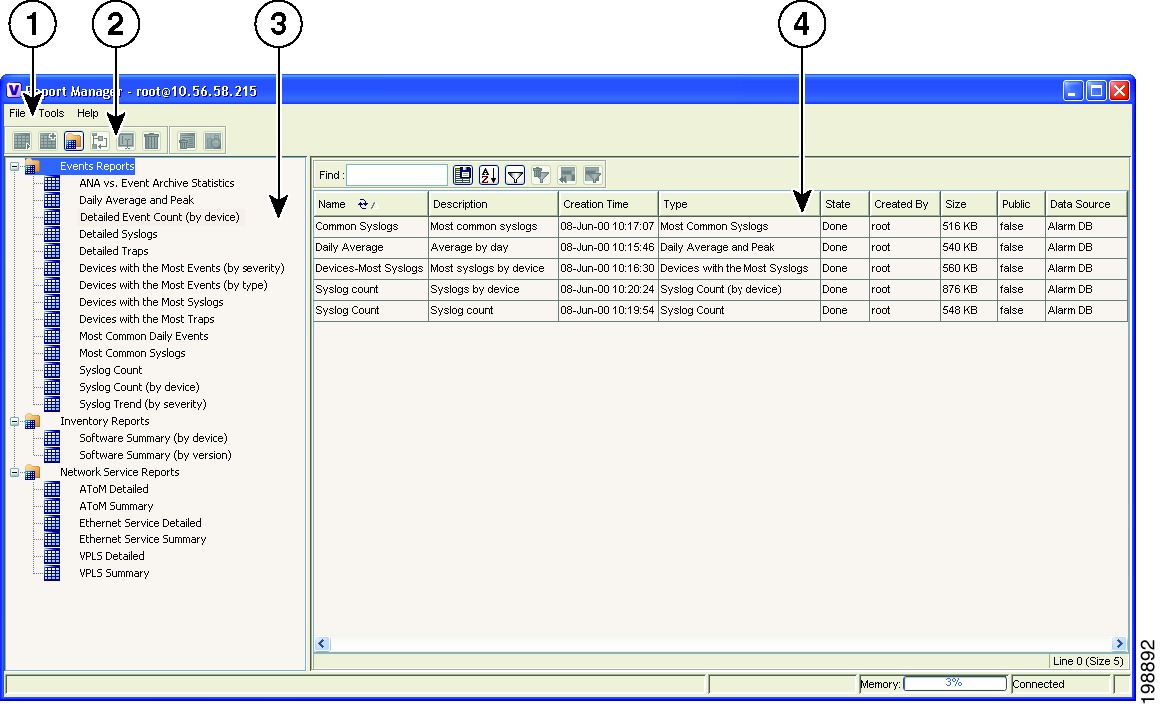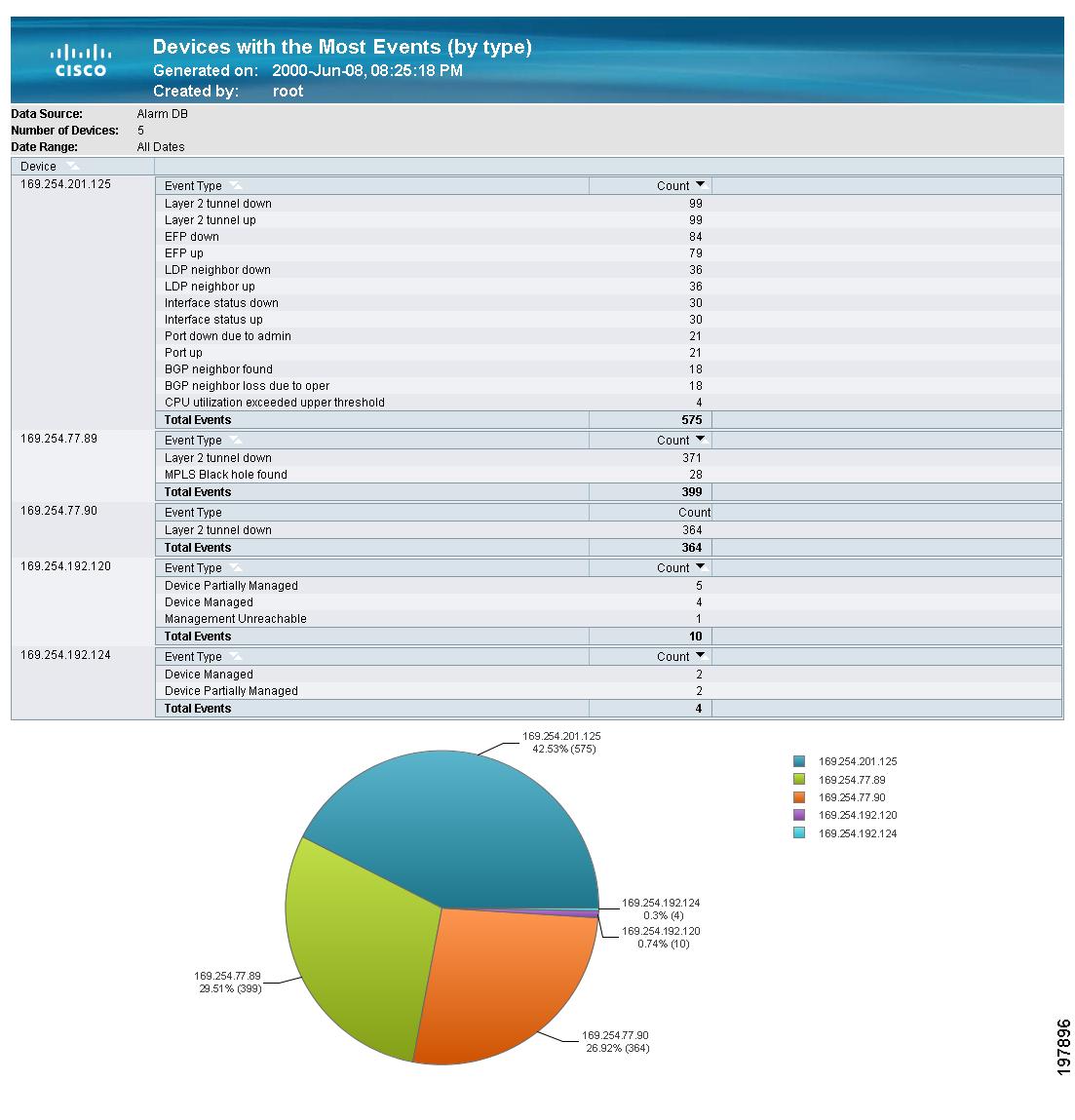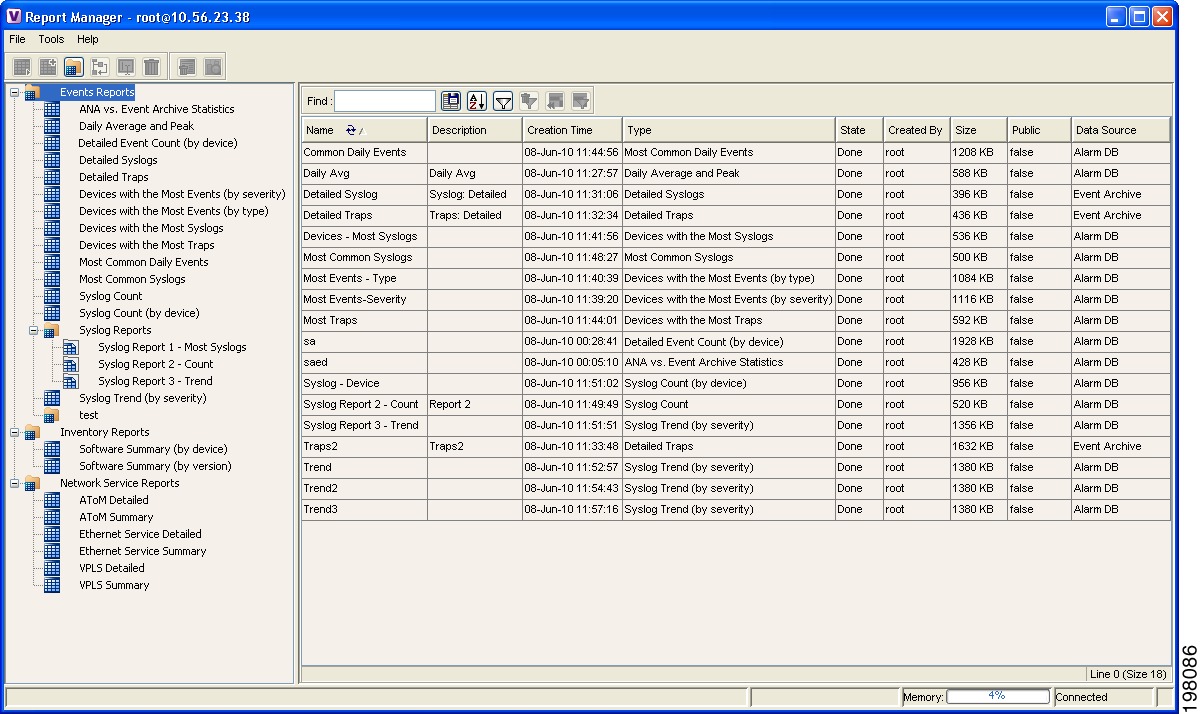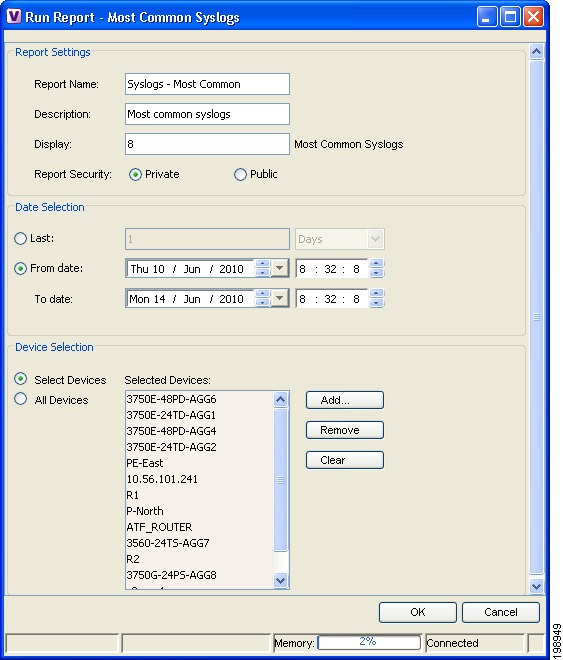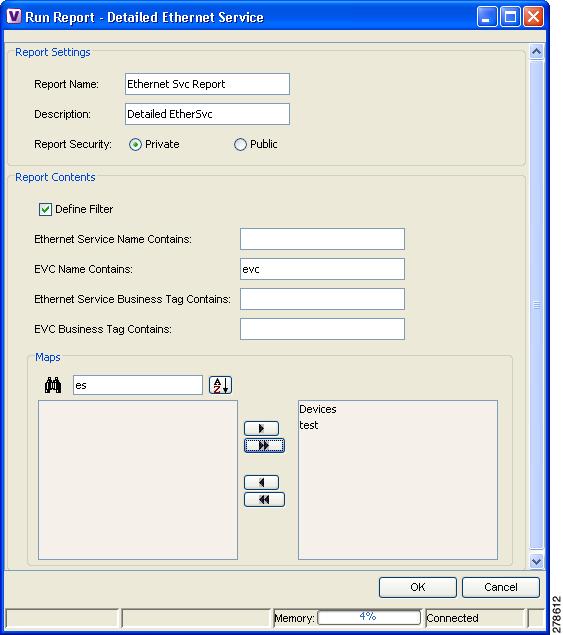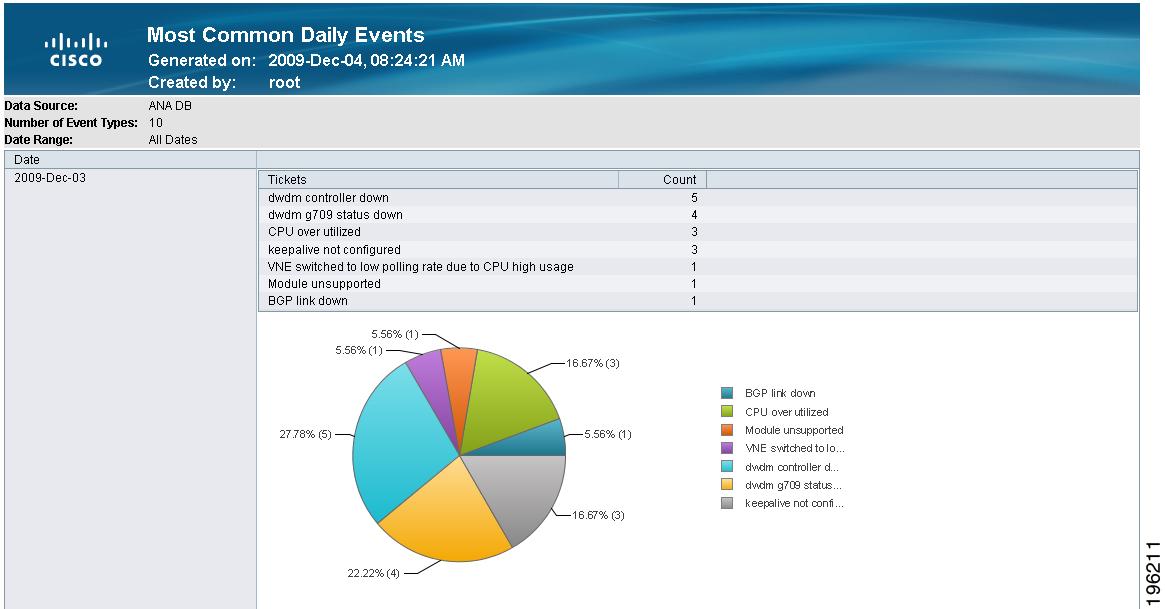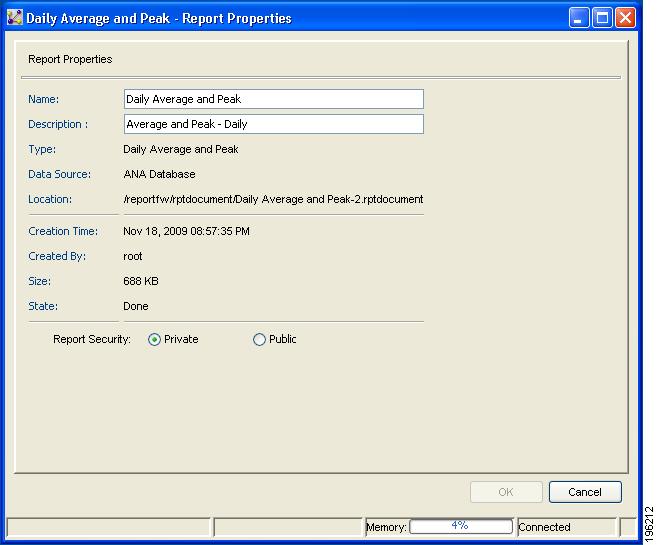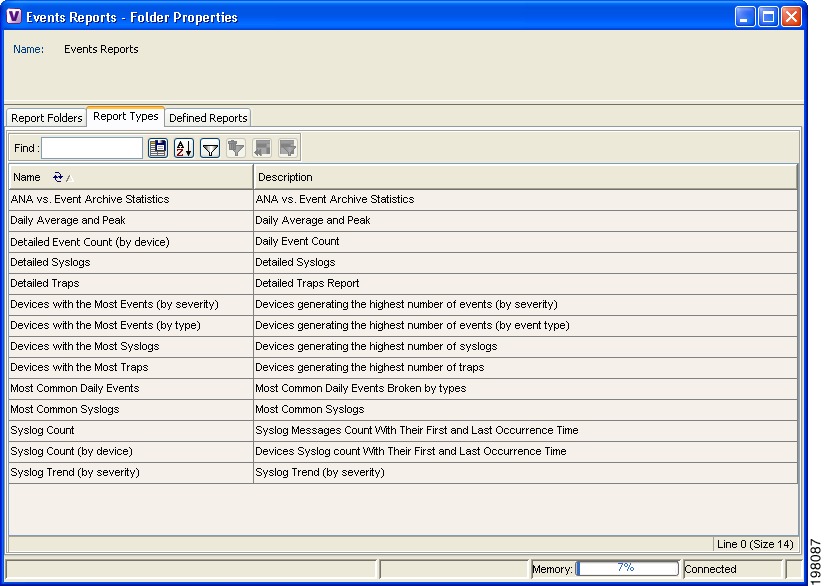

-
Cisco Active Network Abstraction User Guide, 3.7.1
-
Preface
-
Cisco ANA Client Overview
-
Working with the Cisco ANA NetworkVision Client
-
Viewing Network Element Properties
-
Working with Cisco ANA NetworkVision Maps
-
Working with Links
-
Working with Business Tags and Business Elements
-
Working with the Cisco ANA EventVision Client
-
Tracking Faults Using Cisco ANA EventVision
-
Working with Tickets in Cisco ANA NetworkVision
-
Working with Reports
-
Using Cisco ANA PathTracer to Diagnose Problems
-
Monitoring Carrier Ethernet Services
-
Monitoring Carrier-Grade NAT Properties
-
Monitoring DWDM Properties
-
Viewing Ethernet Operations, Administration, and Maintenance Tool Properties
-
IPv6 and IPv6 VPN over MPLS
-
Monitoring MPLS Services
-
Monitoring MToP Services
-
Viewing SBC Properties
-
Icon Reference
-
Index
-
Table Of Contents
User Roles Required to Manage Reports
Generating Reports from Report Manager
Generating Network Service Reports
Generating Reports from the Reports Menu
Generating Reports from Cisco ANA NetworkVision
Managing the Maximum Number of Concurrent Reports
Moving Reports Between Folders
Viewing Folder and Report Type Properties
Viewing Report Folder Properties
Viewing Report Type Properties
Working with Reports
Cisco ANA provides a Report Manager that enables you to generate, view, and export reports of the information managed by Cisco ANA. You can save the generated reports in any of the following formats: PDF, CSV, HTML, XLS, and XML.
In addition to a variety of standard reports for events and inventory, you can define reports as required for your environment. The following topics discuss the Report Manager and reports in more detail:
•
User Roles Required to Manage Reports
User Roles Required to Manage Reports
Table 10-1 identifies the roles that are required to manage reports. Cisco ANA determines whether you are authorized to perform a task as follows:
•
For GUI-based tasks (tasks that do not affect devices), authorization is based on the default permission that is assigned to your user account.
•
For device-based tasks (tasks that do affect devices), authorization is based on the default permission that is assigned to your account. That is, whether the device is in one of your assigned scopes and whether you meet the minimum security level for that scope.
For more information on user authorization, see the Cisco Active Network Abstraction 3.7.1 Administrator Guide.
Using the Report Manager
The Report Manager is available from Cisco ANA NetworkVision, Cisco ANA EventVision, and Cisco ANA Manage by choosing Reports > Report Manager. The Report Manager (shown in Figure 10-1) enables you to run standard reports, such as the number of syslogs by device.
The Report Manager also enables you to create reports and folders, view previously generated reports, define report types for your use, and organize reports in a manner suited to your environment and needs.
Figure 10-1 Report Manager Window
Figure 10-2 shows an example of a generated report with a pie chart.
Figure 10-2 Sample Report
If you hover your mouse cursor over a section in the pie chart, a tooltip displays the information associated with that section, such as IP address, number of events, and percentage of total events.
Note
Not all reports include pie charts. In addition, reports that normally include a pie chart do not display a pie chart if the chart exceeds 25 slices.
Menu Options
Table 10-2 describes the menu options available in the Report Manager window.
Toolbar Icons
Table 10-3 identifies the icons that appear in the Report Manager toolbar.
Navigation Tree
The navigation pane displays a tree-and-branch representation of report folders and types of reports. The highest level in the tree displays report folders. The following standard report folders are provided in Report Manager:
•
Events Reports
•
Inventory Reports
•
Network Service Reports
Each folder contains the types of reports that are provided with Cisco ANA and any user-defined reports. For more information on the standard report types, see Table 10-8.
When you select an item in the tree, the content pane displays the generated reports as follows:
•
If you select a folder, the content pane lists all reports that have been generated using any of the report types in that folder.
•
If you select a report type, the content pane lists all reports that have been generated of that report type.
Content Pane
The content pane lists all reports generated for the folder or report type selected in the navigation tree. You can double-click a report to view the report in HTML format.
Figure 10-3 shows an example of the content pane.
Figure 10-3 Reports Manager Content Pane
Table 10-4 describes the information displayed in the content pane for each report.
Note
Reports are purged from Cisco ANA after 90 days by default. This setting can be modified by changing the setting in Cisco ANA Manage. For more information, see the Cisco Active Network Abstraction 3.7.1 Administrator Guide.
Right-Click Options
Right-click options are available for:
Navigation Pane Folders
Table 10-5 describes the options available when you right-click a folder in the navigation pane.
Table 10-5 Report Manager Navigation Pane Folder Right-Click Options
New Folder
Creates a new folder.
Delete
Deletes a user-defined folder.
Rename
Renames a user-defined folder.
Move
Moves a user-defined folder.
Properties
Displays the Folder Properties window which lists the folder contents. For more information on the Reports Category Properties window, see Viewing Folder and Report Type Properties.
Navigation Pane Reports
Table 10-6 describes the options available when you right-click a report in the navigation pane.
Table 10-6 Report Manager Navigation Pane Report Right-Click Options
Run
Displays the Run Report dialog box so you can run a report of this type specifically for your environment and adds the generated report to the table in the content pane.
Define Report of This Type
Displays the Define Report dialog box so you can create a report of this type specifically for your environment, and adds the newly defined report to the navigation tree.
Move
Moves a user-defined report.
Properties
Displays the Reports Type Properties window which includes a brief description of the report and enables you to generate the report. For more information on the Reports Type Properties window, see Viewing Report Properties.
Content Pane Reports
Table 10-7 describes the options available when you right-click a report in the content pane.
Table 10-7 Report Manager Content Pane Report Right-Click Options
View As
Displays the report in the selected format:
•
HTML
•
•
CSV
•
XLS
•
XML
The default option, HTML, is displayed in bold font. For more information on viewing reports, see Viewing and Saving Reports.
Rename
Renames the selected report.
Share or Unshare
Shares the selected reports or limits them to your viewing only. The option toggles between Share and Unshare, as appropriate for the selected reports.
By default, the Share and Unshare options are available only to users with administrator access. These options are available to other users only if an administrator has enabled sharing in Cisco ANA Manage. For more information, see the Cisco Active Network Abstraction 3.7.1 Administrator Guide.
Delete Report
Deletes the selected reports.
Show Only Selected Rows
Displays only the rows that you select.
Show All Rows
Displays all table rows that meet the current filtering criteria.
Properties
Displays the Reports Type Properties window, which includes a brief description of the report and enables you to edit its name and description.
Report Categories
Cisco ANA provides reports related to:
•
Events—See Events Reports.
•
Inventory—See Inventory Reports.
•
Network services—See Network Service Reports.
Events Reports
Table 10-8 describes the standard events report types provided by Cisco ANA.
Inventory Reports
Table 10-9 describes the standard inventory report types provided by Cisco ANA.
Network Service Reports
Table 10-10 describes the standard network service report types provided by Cisco ANA.
Generating Reports
You can generate reports in any of the following ways:
•
Generating Reports from Report Manager
•
Generating Reports from the Reports Menu
•
Generating Reports from Cisco ANA NetworkVision
Generating Reports from Report Manager
Cisco ANA provides three types of reports as described in Report Categories. The information that you need to provide when generating a report depends on the report type. The following topics describe the information required to generate each report type:
•
Generating Network Service Reports
Generating Events Reports
To generate an events report using Report Manager:
Step 1
In Cisco ANA NetworkVision, Cisco ANA EventVision, or Cisco ANA Manage, choose Reports > Report Manager.
Step 2
In the Report Manager window, choose Events Reports > report-type.
For information on the standard reports available for events, see Table 10-8.
Step 3
Generate the report in either of the following ways:
•
Click Run in the toolbar.
•
Right-click the report type, then choose Run.
The Run Report dialog box is displayed as shown in Figure 10-4. The fields displayed in the Run Report dialog box vary depending on the type of report.
Figure 10-4 Events Report - Run Report Dialog Box
Step 4
In the Run Report dialog box, specify the report settings as described in Table 10-11.
Table 10-11 Events Report - Run Report Dialog Box Fields
Report Name
Enter a unique name for the report.
Description
Enter a brief description of the report.
Display
This field does not appear for all reports.
Enter the number of items to be displayed in the generated report.
Include pie charts in report output
This field does not appear for all reports.
Check this check box to view pie charts in the report with the standard numerical output.
Report Security
Indicate the level of security for the report by clicking the appropriate option:
•
Private—The report can be viewed and used only by the report creator and the administrator.
•
Public—The report can be viewed and used by all other users, regardless of whether the devices are listed in the report are in the user's scope.
Note
You can share reports with others only if sharing is enabled in Cisco ANA Manage. For more information, see the Cisco Active Network Abstraction 3.7.1 Administrator Guide.
Data Source
Depending on the report, this field:
•
Does not appear.
•
Is a read-only field.
•
Allows you to specify the source of information to use for the report: ANA Database or Event Archive.
Last
Specify the length of time before the current date and time, and the unit of measure: seconds, minutes, hours, days, weeks, or months.
From Date
To Date
Specify the date range for the report:
1.
Click From Date.
2.
In the From date field, enter the start date for the time period, or click the drop-down arrow to select the start date from a calendar.
3.
Enter a time for the start date, using the format HH MM SS.
4.
In the To Date field, enter the end date for the time period, or click the drop-down arrow to select the end date from a calendar.
5.
Enter a time for the end date, using the format HH MM SS.
Version
This field does not appear for all reports.
Specify the SNMP version to include in the report: All, 1, 2, or 3.
Generic
This field does not appear for all reports.
Specify the generic traps to include in the report:
1.
Select the generic traps to include in the report:
–
All—Include all generic traps
–
0—coldStart
–
1—warmStart
–
2—linkDown
–
3—linkUp
–
4—authenticationFailure
–
5—egpNeighborLoss
–
6—enterpriseSpecific
2.
If you select generic type 6, enter the OIDs (comma separated) in the Display field.
Select Devices
Select devices to include in the report:
1.
Click Select Devices.
2.
Click Add.
3.
In the Add Network Element dialog box, select devices using either of the following methods:
–
To select a specific network element or category of network elements:
a. Click Search.
b. In the drop-down list, choose the search category: Element Category, Element Type, IP Address, System Name, or Vendor.
c. In the Search field, enter the string that you want to match.
d. Click Go.
–
To select from all network elements, click Show All.
4.
In the Available Network Elements table, select the network elements that you want to include in the report. You can select multiple network elements at a time.
5.
Click OK.
All devices
Click All Devices to include all devices in your scope in the report.
Intervals
This field does not appear for all reports.
In the Grouped by drop-down list, choose the unit of time to use for tracking the trend: Seconds, Minutes, Hours, Days.
Severity
This field does not appear for all reports.
Check the check boxes of the syslog message severities to be included in the report: All, Critical, Major, Minor, Warning, Cleared, Information, and Indeterminate.
Syslog Messages
This field does not appear for all reports.
Specify the syslog messages to be included in the report:
•
To include selected syslog messages in the report, in the list of syslog messages on the left, select the required syslog messages, and then click Add Selected to move them to the list of syslog messages on the right.
•
To include all syslog messages in the report, click Add All.
To find syslog messages that match a string, enter the string in the Find field. The list of syslog messages is automatically updated to include only those messages that contain the string you enter.
Click the Sort Order button to sort the syslog messages alphabetically or in reverse alphabetic order.
Step 5
Click OK.
The report appears in the table in the content pane with a state of Running. When the report is complete, the state changes to Done.
You can view the reports when the state is Done. Occasionally, some report formats require additional time for generation. If so, a progress bar is displayed, indicating that the report is being created and will be available soon.
If no data is found for the report, the report states that no results were found.
Generating Inventory Reports
To generate an inventory report using Report Manager:
Step 1
In Cisco ANA NetworkVision, Cisco ANA EventVision, or Cisco ANA Manage, choose Reports > Report Manager.
Step 2
In the Report Manager window, choose Inventory Reports > report-type.
For information on the standard reports available for inventory, see Table 10-8.
Step 3
Generate the report in either of the following ways:
•
Click Run in the toolbar.
•
Right-click the report type, then choose Run.
The Run Report dialog box is displayed as shown in Figure 10-5.
Figure 10-5 Inventory Report - Run Report Dialog Box
Step 4
Enter the required information in the Run Report dialog box as described in Table 10-12.
Table 10-12 Inventory Report - Run Report Dialog Box Fields
Report Name
Enter a unique name for the report.
Description
Enter a brief description of the report.
Report Security
Indicate the level of security for the report by clicking the appropriate option:
•
Private—The report can be viewed and used only by the report creator and the administrator.
•
Public—The report can be viewed and used by all other users, regardless of whether the devices are listed in the report are in the user's scope.
Note
You can share reports with others only if sharing is enabled in Cisco ANA Manage. For more information, see the Cisco Active Network Abstraction 3.7.1 Administrator Guide.
Select Devices
Select devices to include in the report:
1.
Click Select Devices.
2.
Click Add.
3.
In the Add Network Element dialog box, select devices using either of the following methods:
–
To select a specific network element or category of network elements:
a. Click Search.
b. In the drop-down list, choose the search category: Element Category, Element Type, IP Address, System Name, or Vendor.
c. In the Search field, enter the string that you want to match.
d. Click Go.
–
To select from all network elements, click Show All.
4.
In the Available Network Elements table, select the network elements that you want to include in the report. You can select multiple network elements at a time.
5.
Click OK.
All devices
Click All Devices to include all devices in your scope in the report.
Step 5
Click OK.
The report appears in the table in the content pane with a state of Running. When the report is complete, the state changes to Done.
You can view the reports when the state is Done. Occasionally, some report formats require additional time for generation. If so, a progress bar is displayed, indicating that the report is being created and will be available soon.
If no data is found for the report, the report states that no results were found.
Generating Network Service Reports
To generate a network service report using Report Manager:
Step 1
In Cisco ANA NetworkVision, Cisco ANA EventVision, or Cisco ANA Manage, choose Reports > Report Manager.
Step 2
In the Report Manager window, choose Network Service Reports > report-type.
For information on the standard reports available for network services, see Table 10-8.
Step 3
Generate the report in either of the following ways:
•
Click Run in the toolbar.
•
Right-click the report type, then choose Run.
The Run Report dialog box is displayed as shown in Figure 10-6.
Figure 10-6 Network Service Report - Run Report Dialog Box
Step 4
Enter the required information the Run Report dialog box as described in Table 10-13.
Table 10-13 Network Service Report - Run Report Dialog Box Fields
Report Name
Enter a unique name for the report.
Description
Enter a brief description of the report.
Report Security
Indicate the level of security for the report by clicking the appropriate option:
•
Private—The report can be viewed and used only by the report creator and the administrator.
•
Public—The report can be viewed and used by all other users, regardless of whether the devices are listed in the report are in the user's scope.
Note
You can share reports with others only if sharing is enabled in Cisco ANA Manage. For more information, see the Cisco Active Network Abstraction 3.7.1 Administrator Guide.
Define Filter
Check the Define Filter check box to enter criteria that must be matched for inclusion in the report.
Pseudowire Name Contains
Enter a string that must appear in the pseudowire name for the pseudowire to be included in the report.
Pseudowire Type Contains
Enter a string that must appear in the pseudowire type for the pseudowire to be included in the report.
Pseudowire Business Tag Contains
Enter a string that must appear in the pseudowire business tag for the pseudowire to be included in the report.
Maps
Specify the maps to include in the report:
•
To include specific maps in the report, in the list of maps on the left, select the required maps, and then click Add Selected to move them to the list of maps on the right.
•
To include all maps in the report, click Add All.
To find maps that match a string, enter the string in the Find field. The list of maps is automatically updated to include only those maps that contain the string you enter.
Click the Sort Order button to sort the maps alphabetically or in reverse alphabetic order.
Define Filter
Check the Define Filter check box to enter criteria that must be matched for inclusion in the report.
Ethernet Service Name Contains
Enter a string that must appear in the Ethernet service name for the Ethernet service to be included in the report.
EVC Name Contains
Enter a string that must appear in the EVC name for the EVC to be included in the report.
Ethernet Service Business Tag Contains
Enter a string that must appear in the Ethernet service business tag for the Ethernet service to be included in the report.
EVC Business Tag Contains
Enter a string that must appear in the EVC business tag for the EVC to be included in the report.
Maps
Specify the maps to include in the report:
•
To include specific maps in the report, in the list of maps on the left, select the required maps, and then click Add Selected to move them to the list of maps on the right.
•
To include all maps in the report, click Add All.
To find maps that match a string, enter the string in the Find field. The list of maps is automatically updated to include only those maps that contain the string you enter.
Click the Sort Order button to sort the maps alphabetically or in reverse alphabetic order.
Define Filter
Check the Define Filter check box to enter criteria that must be matched for inclusion in the report.
VPLS Name Contains
Enter a string that must appear in the VPLS name for the VPLS or H-VPLS to be included in the report.
VPLS Business Tag Contains
Enter a string that must appear in the VPLS business tag for the VPLS or H-VPLS to be included in the report.
Maps
Specify the maps to be included in the report:
•
To include specific maps in the report, in the list of maps on the left, select the required maps, and then click Add Selected to move them to the list of maps on the right.
•
To include all maps in the report, click Add All.
To find maps that match a string, enter the string in the Find field. The list of maps is automatically updated to include only those maps that contain the string you enter.
Click the Sort Order button to sort the maps alphabetically or in reverse alphabetic order.
Step 5
Click OK.
The report appears in the table in the content pane with a state of Running. When the report is complete, the state changes to Done.
You can view the reports when the state is Done. Occasionally, some report formats require additional time for generation. If so, a progress bar is displayed, indicating that the report is being created and will be available soon.
If no data is found for the report, the report states that no results were found.
Generating Reports from the Reports Menu
To generate reports quickly and without opening the Reports Manager window, choose Reports > Run Report > folder > report-type. The menus include all standard folders and reports, and any folders or reports that you have created. After entering the required information, you can view the report as soon as it is generated or at a later time.
To generate a report from the Reports menu:
Step 1
Choose Reports > Run Report > folder > report-type where:
•
folder is the required folder.
•
report-type is the required type of report.
Step 2
In the Run Report dialog box, enter the required information. For more information on the options in the Run Report dialog box, see Table 10-11.
Step 3
Click OK.
Step 4
In the Running Report dialog box, specify the viewing options:
a.
Check the Open Report Manager to monitor status check box to open the Report Manager window so that you can view the report generation process. Uncheck the check box to proceed without opening the Report Manager window.
b.
Check the View report immediately upon completion check box to view the report as soon as it is generated. If you enable this option, the report is displayed in HTML format as soon as it is complete. Uncheck the check box to view the report at a later time by using Report Manager.
Step 5
Click OK.
Depending on your selections in Step 4, the Report Manager window is displayed, the report is displayed, or the report is available for viewing at a later time.
Generating Reports from Cisco ANA NetworkVision
Cisco ANA NetworkVision enables you to run reports on selected devices from the map and list views.
To generate a report from Cisco ANA NetworkVision:
Step 1
In Cisco ANA NetworkVision, select the required devices in the map or list view.
Step 2
In the navigation tree or content pane, right-click the selected devices, then choose Run Report > folder > report-type.
Step 3
In the Run Report dialog box, enter the required information as described in Table 10-11.
The devices that you select in the navigation pane or content pane are automatically included in the report.
Step 4
Click OK.
Step 5
In the Running Report dialog box, specify the viewing options:
a.
Check the Open Report Manager to monitor status check box to open the Report Manager window so that you can view the report generation process. Uncheck the check box to proceed without opening the Report Manager window.
b.
Check the View report immediately upon completion check box to view the report as soon as it is generated. If you enable this option, the report is displayed in HTML format as soon as it is complete. Uncheck the check box to view the report at a later time by using Report Manager.
Depending on your selections in Step 5, the Report Manager window is displayed, the report is displayed, or the report is available for viewing at a later time.
Managing Reports
Cisco ANA provides the following options for working with reports:
•
Managing the Maximum Number of Concurrent Reports
•
Moving Reports Between Folders
Managing the Maximum Number of Concurrent Reports
Cisco ANA enables you to run multiple reports at the same time, with the maximum number of concurrent reports set at 5 by default. As the event rate approaches the maximum committed event rate, we recommend that you decrease the maximum number of concurrent reports.
The maximum number of concurrent reports is defined in the registry, in reports.xml, under site/reports/reports-setting/reports-running-settings/maxRunningReports.
Note
Changes to the registry should only be carried out with the support of Cisco. For details, contact your Cisco account representative.
To change the maximum number of concurrent reports, use the runRegTool command (located in ANAHOME/Main) as follows:
./runRegTool.sh -gs 127.0.0.1 set 0.0.0.0 site/reports/reports-setting/reports-running-settings/maxRunningReports valuewhere value is the new maximum number of concurrent reports.
You do not need to restart any AVMs after entering this command.
For more information on the runRegTool command, see the Cisco Active Network Abstraction 3.7.1 Administrator Guide.
Viewing and Saving Reports
You can view any reports that appear in the Report Manager content pane as long as the state is Done. After viewing a report, you can save it in any of the available formats.
Note
Reports are purged from Cisco ANA after 90 days by default. This setting can be modified by changing the setting in Cisco ANA Manage. For more information, see the Cisco Active Network Abstraction 3.7.1 Administrator Guide.
To view and save a report:
Step 1
Choose Reports > Report Manager.
Step 2
In the navigation pane, locate the required report in either of the following ways:
•
Select the folder containing the report.
•
Select the report type.
Step 3
In the content pane, right-click the report, then choose View As > format where format is one of the following:
•
HTML—Displays the report in a browser window. Clicking a column heading in the report sorts the report by that value; clicking the column heading again sorts the data in the reverse order. HTML is the default format.
•
PDF—Displays a PDF version of the report.
•
CSV—Creates a CSV version of the report that you can either save to a specific location or view using another application. The CSV version contains only the report data; it does not contain the header information, layout, or formatting information that is available in other formats.
•
XLS—Creates an XLS version of the report that you can either save to a specific location or view using another application, such as Microsoft Excel.
•
XML—Creates an XML version of the report that you can either save to a specific location or view using an XML editor or viewer.
Figure 10-7 is an example of the Most Common Daily Events report in HTML format. The data is sorted by the Count column, in descending order.
Figure 10-7 Most Common Daily Events Report Example
Step 4
Save the report as required.
Renaming Reports
You can rename:
•
Any report type that you defined.
•
Any generated report that you have access to.
You cannot rename any of the Cisco ANA standard report types.
Renaming a User-Defined Report Type
Note
When you rename a report type, the new name applies to only those reports that you run after changing the name; it does not change the names of reports that were run prior to changing the name.
To rename a user-defined report type:
Step 1
In the navigation tree, select the user-defined report type.
Step 2
Right-click the report type, then choose Properties.
Step 3
In the Edit dialog box, enter a new name for the report type in the Report Name field.
Step 4
Click OK.
The navigation pane is refreshed and the report type is displayed with the new name.
Renaming a Generated Report
To rename a report:
Step 1
Choose Reports > Report Manager.
Step 2
In the navigation pane, locate the required report in either of the following ways:
•
Select the folder containing the report.
•
Select the report type.
Step 3
In the content pane, right-click the report that you want to rename, then choose Rename.
Step 4
In the Rename Report dialog box, enter the new name for the report.
Step 5
Click OK.
The content pane is refreshed and the report is displayed with the new name.
Sharing Reports
Cisco ANA enables you to share reports that you generate with other users, or limit access to a report to only you and the administrator.
Note
You can share reports with others only if sharing is enabled in Cisco ANA Manage. For more information, see the Cisco Active Network Abstraction 3.7.1 Administrator Guide.
Sharing a Report
To share access to a report that you generated:
Step 1
Choose Reports > Report Manager.
Step 2
In the navigation pane, locate the required report in either of the following ways:
•
Select the folder containing the report.
•
Select the report type.
Step 3
In the content pane, right-click the report that you want to share, then choose Share.
The report is available to all system users for viewing and using.
Limiting Access to a Report
To limit access to a report that you generated and subsequently shared:
Step 1
Choose Reports > Report Manager.
Step 2
In the navigation pane, locate the required report in either of the following ways:
•
Select the folder containing the report.
•
Select the report type.
Step 3
In the content pane, right-click the report that you want to limit access to, then choose Unshare.
The report can be viewed and used by only you and the administrator.
Moving Reports Between Folders
You can move a report type that you have defined from the current folder to another folder in the navigation tree.
Note
You cannot move a standard report type from one folder to another.
To move a report type to a new folder:
Step 1
Choose Reports > Report Manager.
Step 2
In the navigation tree, select the required report that you have defined.
Step 3
Do either of the following:
•
Click Move in the toolbar.
•
Right-click the report, then choose Move.
Step 4
In the Move To dialog box, select the folder to which you want to move the report.
Step 5
Click OK.
The Report Manager window is refreshed and the report appears in the specified folder.
Deleting Reports
You can delete reports to which you have access.
To delete a report:
Step 1
Choose Reports > Report Manager.
Step 2
In the navigation pane, locate the required report in either of the following ways:
•
Select the folder containing the report.
•
Select the report type.
Step 3
In the content pane, select the required report.
Step 4
Delete the report in either of the following ways:
•
Right-click the report, then choose Delete Report.
•
Click Delete Report in the toolbar.
Step 5
In the Delete Report confirmation window, click Yes to confirm deletion.
The Report Manager window is refreshed and the deleted report no longer appears.
Viewing Report Properties
The Report Properties dialog box enables you to view the report settings and to modify some of them.
To view report properties, and optionally change the name, description, or access:
Step 1
Choose Reports > Report Manager.
Step 2
In the navigation pane, locate the required report in either of the following ways:
•
Select the folder containing the report.
•
Select the report type.
Step 3
In the content pane, right-click the selected report, then choose Properties.
The Report Properties dialog box is displayed, as shown in Figure 10-8.
Figure 10-8 Report Properties Dialog Box
The Report Properties dialog box contains the following information about the report:
•
Name
•
Description
•
Type
•
Source of the information
•
Location of the report on the gateway
•
Date and time it was created
•
User who created it
•
Size
•
State
•
Access
Step 4
Change the information in the following fields as required:
•
Name
•
Description
Step 5
Click OK.
Defining Report Types
You can modify any of the report types provided by Cisco ANA so that it better suits your needs and environment. This is extremely beneficial if you generate a particular type of report for specific devices or events on a regular basis.
To define a report type:
Step 1
Choose Reports > Report Manager.
Step 2
In the navigation pane, select the existing report type on which you want to base your report type and then do either of the following:
•
Right-click the existing report type, then choose Define Report of This Type.
•
Click Define Report of This Type in the toolbar.
Step 3
In the Define report of type dialog box, specify the options using the information in Table 10-11.
Step 4
In the Location field, do either of the following:
•
Use the specified reports folder.
•
Click Browse to select a different folder:
a.
In the Move to dialog box, select the required folder.
b.
Click OK.
Step 5
Click OK.
The newly defined report type appears in the navigation tree in the specified folder.
Working with Report Folders
Cisco ANA provides the following options for working with report folders:
•
Viewing Folder and Report Type Properties
Creating Folders
Cisco ANA enables you to create additional report folders in Report Manager.
To create a report folder:
Step 1
Choose Reports > Report Manager.
Step 2
Select the location of the new folder as follows:
•
To create a folder at the top level in the hierarchy (at the same level as the Events Reports, Inventory Reports, and Network Service Reports folders), click in the navigation pane.
•
To create a folder in an existing folder, select the folder.
Step 3
Depending on your selection in Step 2, continue with one of the following:
•
Click New Folder in the toolbar.
•
Right-click the folder, then choose New Folder.
Step 4
In the New Folder dialog box, enter a name for the folder.
Step 5
Click OK.
The navigation pane is refreshed and the new folder is displayed.
Moving Folders
Cisco ANA enables you to move folders that you have created in Report Manager. You cannot move the Events Reports, Inventory Reports, or Network Service Reports folder.
To move a report folder:
Step 1
Choose Reports > Report Manager.
Step 2
In the navigation pane, select the folder you want to move, and then do one of the following:
•
Click Move in the toolbar.
•
Right-click the folder, then choose Move.
Step 3
In the Move To dialog box, select the location where you want the folder to reside.
Tip
To move the folder to the same level as the folders provided by Cisco ANA, click the white space in the Move To dialog box so that none of the top-level folders are selected.
Step 4
Click OK.
The navigation pane is refreshed and the folder is displayed in the new location.
Renaming Folders
Cisco ANA enables you to rename folders that you have created in Report Manager. You cannot:
•
Rename a folder that resides at the highest level in the hierarchy, such as the Events Reports, Inventory Reports, or Network Service Reports folder.
•
Use the same name for different folders that reside at the same level in the hierarchy.
To rename a report folder:
Step 1
Choose Reports > Report Manager.
Step 2
In the navigation pane, select the folder you want to rename, and then do one of the following:
•
Click Rename in the toolbar.
•
Right-click the folder, then choose Rename.
Step 3
In the Rename Folder dialog box, enter the new name for the folder.
Step 4
Click OK.
The navigation pane is refreshed and the folder is displayed with the new name.
Deleting Folders
You can delete folders that you have created in Report Manager if they are empty. You cannot delete the following folders:
•
Events Reports folder
•
Inventory Reports folder
•
Network Service Reports folder
•
User-created folders that contain other folders or report types
To delete a report folder:
Step 1
Choose Reports > Report Manager.
Step 2
In the navigation pane, select the folder you want to delete, and then do one of the following:
•
Click Delete in the toolbar.
•
Right-click the folder, then choose Delete.
Step 3
In the Confirm Folder Delete dialog box, click Yes to confirm the deletion.
The navigation pane is refreshed and the folder no longer appears.
Viewing Folder and Report Type Properties
The following topics describe how to view properties for folders and report types:
•
Viewing Report Folder Properties
•
Viewing Report Type Properties
Viewing Report Folder Properties
The Report Properties window enables you to view report properties and to add folders.
To view report properties:
Step 1
Choose Reports > Report Manager.
Step 2
In the navigation pane, right-click the required folder, then choose Properties.
The Folder Properties window is displayed, as shown in Figure 10-9.
Figure 10-9 Folder Properties
Table 10-14 describes the information that is displayed in each tab, depending on the folder's contents.
Viewing Report Type Properties
To view report type properties:
Step 1
In the navigation pane, right-click the required report type, then choose Properties.
The information that is displayed depends on whether the report type is one that you defined or one provided by Cisco ANA:
•
User-defined report type—The Edit dialog box is displayed with all settings specified for the report type. You can modify the settings or leave them as they are.
•
Cisco ANA-provided report type—The Report Type Properties window is displayed with the report name and description. Click Run to generate the report.
Step 2
Click the upper right corner to close the window.

 Feedback
Feedback